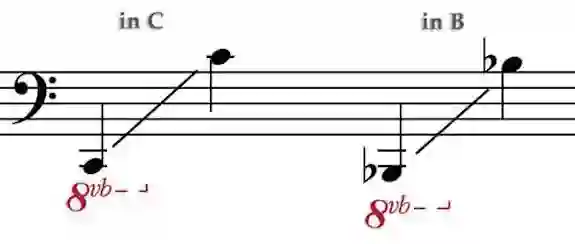Notation, sound generation, Contrabass tuba, Philipp Dangas
Notation - sound generation - Contrabass tuba
It is the largest tuba instrument. It is also known as the "Kaiserbass", sometimes also a 16' or 18' (contra) bass tuba. Another designation is CC or BB tuba, although the first designation is not entirely correct. The fundamental C is only a contra-C, whereas the B is really a sub-contra B (B2) and this alone deserves the designation BB. The basic scale of the contrabass tuba in C is the natural scale built on the C1: C1—C—G—c—e—g—b—c1. This basic scale can be lowered by 11 semitones to the Db2 scale with the help of the 4 valves and possibly one or more compensation valves.
The theoretically possible continuation of the scale of fundamental tones towards depth exceeds the limits of human lung power. In general, the C1 is the extreme limit in depth. The tones from D flat to C are played by overblowing. The tonal response of the C1, which can be played with the valves closed, i.e. in the original tuning, is relatively better than that of the Db1 or D1. In the high register, the scale limit for the contrabass tuba in C is c1. The contrabass tuba, whether in C or Bb, is notated in bass clef .
Download size: 133 kilobytes
Table summary of playing techniques on the contrabass tuba
The following table shows the playing techniques and playing effects on the brass instrument of a double bass tuba. The playing techniques that are not suitable are also briefly mentioned.

The tonal range of a contrabass tuba in large scale
Internal search function
| Name | Value | Delete |
|---|